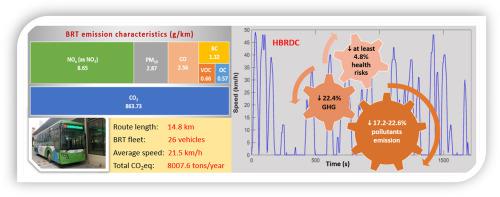Atmospheric Pollution Research ( IF 3.9 ) Pub Date : 2021-07-21 , DOI: 10.1016/j.apr.2021.101148 Yen-Lien T. Nguyen 1 , Trung-Dung Nghiem 2 , Anh-Tuan Le 3 , Khanh Nguyen Duc 3 , Duy-Hung Nguyen 4

|
In this paper, the environmental efficiency of the bus rapid transit (BRT) in Hanoi was analyzed through estimating the co-benefits of air quality, climate and health. First, the real-world driving data, instantaneous velocity versus time, in the city was collected using the global positioning system (GPS) technology with the signal update of 1 Hz. Then, a data processing procedure consisting of nine steps was applied to remove errors and to smooth the GPS data. After that, the processed GPS data was used to develop the typical driving cycle for BRT in Hanoi based on the Markov chain theory. Emission factors of air pollutants including CO, CO2, VOC, NOx, SO2, and PM10 were determined based on the developed driving cycle with the use of the International Vehicle Emissions (IVE) model. The health effect was estimated using the AirQ+ model. It is found that, compared to the regular buses, deploying the BRT in Hanoi can reduce the emissions of air pollutants 17.3–22.6 % and the amount of CO2eq emission up to 22.4 %. It is also indicated that at least 4.8 % of prevalence of bronchitis symptoms in asthmatic children aged 5–14 years, and 2.4 % of total mortality due to all causes except accidents in aged 30+ years in Hanoi can be reduced through deploying the BRT. Although the average speed of the current BRT in Hanoi is only 1.3 times higher than the regular bus, it could bring to significant benefits in terms of environment and health.
中文翻译:

快速公交的排放特征和协同效益:越南河内的案例研究
在本文中,通过估算空气质量、气候和健康的协同效益,分析了河内快速公交 (BRT) 的环境效率。首先,使用全球定位系统 (GPS) 技术以 1 Hz 的信号更新收集城市中真实世界的驾驶数据,即瞬时速度与时间的关系。然后,应用由九个步骤组成的数据处理程序来消除错误并平滑 GPS 数据。之后,处理后的 GPS 数据用于基于马尔可夫链理论开发河内 BRT 的典型驾驶循环。CO、CO 2、VOC、NO x、SO 2、PM 10等大气污染物排放因子使用国际车辆排放 (IVE) 模型根据开发的驾驶循环确定。使用 AirQ +模型估计健康影响。研究发现,与普通公交车相比,在河内部署BRT可以减少17.3-22.6%的空气污染物排放和高达22.4%的CO 2 eq排放量。还表明,通过部署 BRT,河内 5-14 岁哮喘儿童中至少 4.8% 的支气管炎症状患病率和 2.4% 的除事故以外的所有原因导致的总死亡率降低 2.4%。虽然目前河内 BRT 的平均速度仅比普通巴士高 1.3 倍,但它可以带来显着的环境和健康效益。











































 京公网安备 11010802027423号
京公网安备 11010802027423号